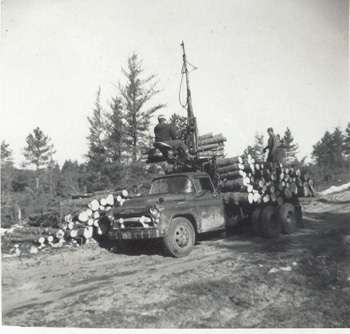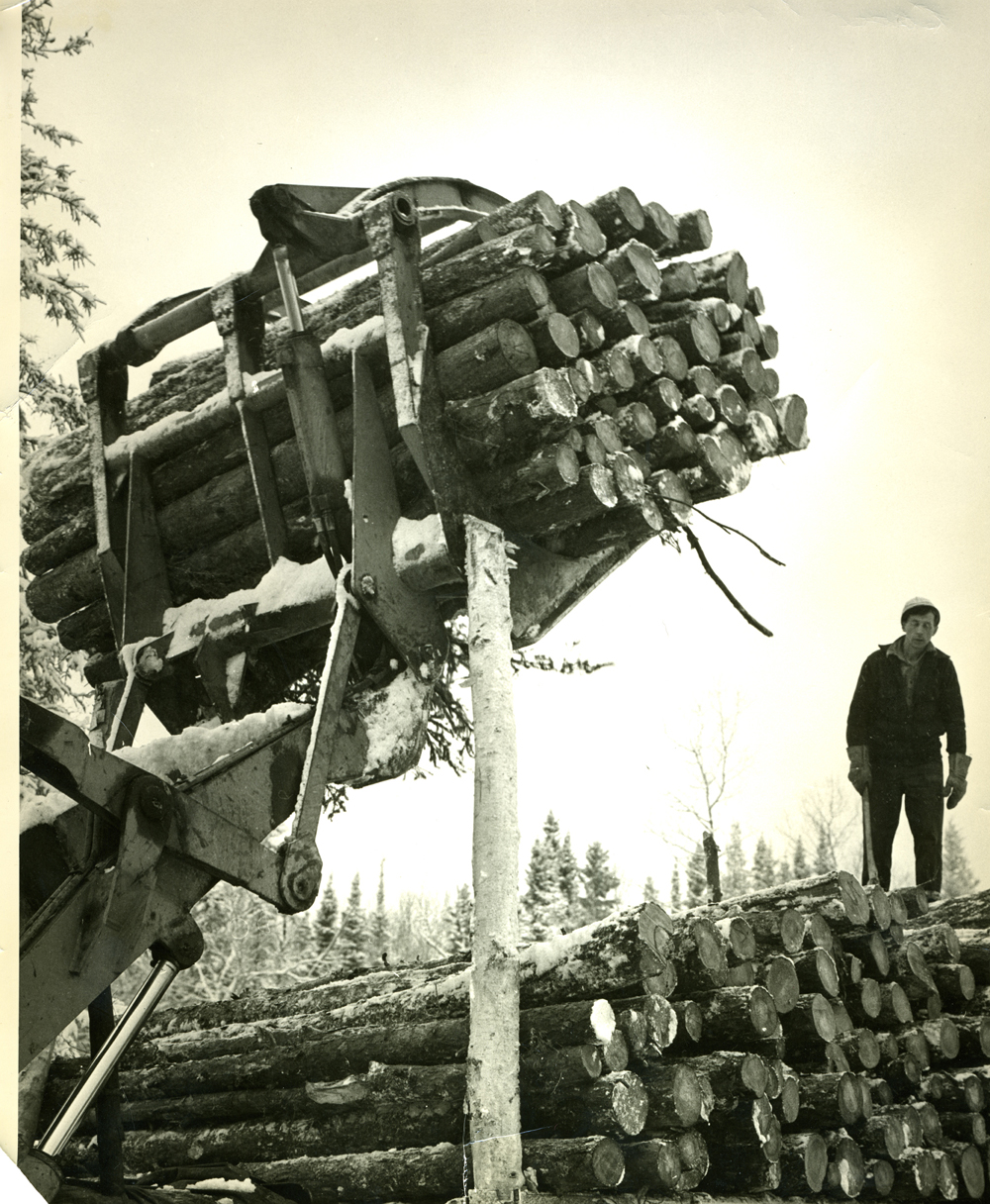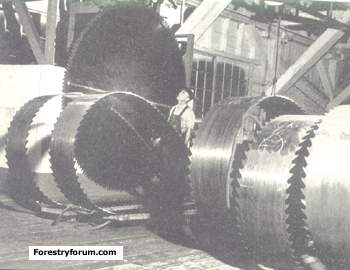In March of 1959 I left school for good and went with Dad to work in the bush. I was sixteen years old. At that time we were living in
My leaving school was not a voluntary occurrence. I was expelled for seven days for fighting in the hall. I always felt that this was unfair because what had happened was not what it looked like. I was returning to the classroom after lunch and had stopped at the water fountain to get a drink. Ahead of me there was a boy filling up a water pistol. After putting the plug back in the pistol he turned and squirted me. Well my instant reaction was to try to grab the pistol from him. It was at precisely that time that the teacher looked out of the classroom. What she saw was me wrestling with this boy. Because I was on top of him she assumed that I was beating him up. So after stopping us she sent me down to the principal's office with a note that said that I had been fighting in the hall. The other boy was just sent back to his room. After a lecture about fighting the principal felt expulsion for seven days was needed.
Now it's important to note that due to learning disabilities I had always struggled in school and that both Dad and I hated the city and missed the lake country. Based on these facts I believe that both Dad and I used my seven day expulsion as an excuse to say that I would never do well in school and the best thing to do was to head back to the lake and start a small logging-trucking business. So leaving May, Lynne and Mom in the city, back to the
Dad knew a man who owned five mining claims very close to
At first we just cut pulpwood and hired someone else to haul it to the Mill in Kenora. Kenora is a small

Picture borrowed from: http://www.forestryforum.com/board/index.php?action=printpage%3Btopic=18781.0%3Bimages
During the first year Dad and I were only able to cut and haul from these claims in the winter because most of them were on the other side of a swamp. We could only haul over this swamp in the winter when it was frozen. So in the summer time we put a dump box on the truck and hauled gravel and sand to some of the summer cottages in the area. By the next summer we had laid a corduroy road and we were able to haul all summer as well. A corduroy road is built over soft or wet areas by placing criss-cross mesh of small poles or slabs. Dad and I used slabs from one of the saw mills in the area. As I remember we put about four or five layers of slabs down and between each layer of slabs we put some sand and gravel. When we were finished our road looked a lot like the road in this picture.

Picture borrowed from: http://vtacorn.net/2008_01_January/2008%20Jan%20more.htm.
The next winter we bought a small tractor for loading pulpwood similar the one in the next two pictures.


These two pictures were borrowed from: http://dhseagles.kpdsb.on.ca/about/drydenPaperMill/stories/franklin/gordonFranklin.html.
The top picture shows a loader with a load of pulpwood ready to be loaded. The next picture shows the pulp wood being loaded onto a truck. Most of the time when we loaded our trucks Dad operated the loader and I was on the truck with the pickaroon. Once in awhile though we changed around and Dad was on the truck. You can't see the head of the pickaroon in the above picture so I added this one for you.

For the first couple of years I could only drive the truck in the bush as you needed a special driver’s to drive a loaded truck on the highway and I had to wait until I was eighteen to get that. Until then, Dad and I worked together cutting lots of trees down. We would then use the tractor to skid them to the loading area. When we had one truck load skidded out we bucked them up into eight foot pieces and load them on the truck. Then Dad would drive the load to the mill while I skidded and bucked the next load. Once these trees were all bucked up the loading area (or landing) looked a lot like this.
When I turned eighteen we bought two larger trucks and hired some men to do the cutting for us. When all the trees had been cut from these mining claims Dad and I went hauling for other timber companies. One company I liked hauling for was Devlin Timber. I remember there was a man from
At other times we would bid on timber sales and if we got them we would hire men to do the cutting while we loaded and hauled the wood to the mill. One winter we hauled pulpwood for the First Nations People who lived on
http://maps.google.ca/maps?hl=en&ie=UTF8&ll=49.53635,-95.085983&spn=0.21924,0.44014&t=h&z=11
When a big truck travels across an ice road there are some physical laws that come into play that may not at first be apparent. Laws like gravity for instance. When a truck load of pulpwood like the one in the next picture is on the ice, the weight of the truck actually pushes the ice down. This means that the truck is actually traveling in a small depression that moves with the truck. This also means that the water below this depression is being push away from the truck as it travels. This water actually forms a wave in front of the truck. The faster the truck travels, the bigger the wave gets. If the truck travels too fast the wave will get big enough to break the ice.

This picture was borrowed from: http://mff.dsisd.net/Products/ToMarket.htm.
If that happens the front wheels of the truck will usually make it over the crack but the weight of the rear wheels will crack the ice some more and the truck will look a lot like this.

That never happen to Dad or me but I did see one truck break through the ice. The driver was able to jump out before the truck slipped below the surface and sink into about twenty meters of water. It’s probably still there today.

This picture was borrowed from: http://www.borealforest.org/index.php?category=ont_nw_forest&page=history&content=future
It shows a truck loaded with pulpwood driving through what is known as an Eynon load-aligner. It was invented by a man named Jack Eynon. Some times when pulpwood is loaded there are some pieces that stick out too far. By driving through the Eynon load-aligner these pieces get pushed in and the load is nice and even. Notice that there are two big drums, one on each side of the load.
I worked with Dad hauling pulpwood until I was twenty-one years old. At that time I felt like traveling and doing other things I never got back to the logging industry again until I came to

Picture borrowed from: http://www.forestryforum.com/board/index.php?action=printpage%3Btopic=18781.0%3Bimages
The big circular saw in this picture is called a slasher saw. Some slasher saws have inserted teeth that are held in with rivets. They look like this;

The other saws in the picture are called double cut band saws. They’re sixteen inches wide when new and the teeth are spaced about three inches apart. These saws go on what is called the head rig.

The other saws in the picture are called double cut band saws. They’re sixteen inches wide when new and the teeth are spaced about three inches apart. These saws go on what is called the head rig.
If you visit this link you will see some great pictures of a lumber mill from the logs arriving on a truck to the cut timbers and lumber ready for shipping.
That’s it for this time. I’ll tell you more next time.